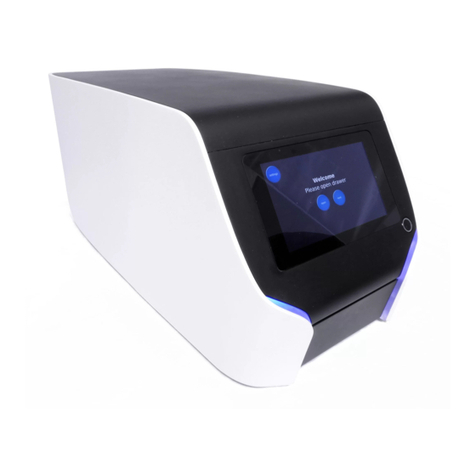
Primer design guidelines
The Xdrop™ enrichment technology relies on carefully designed and highly specific PCR primer pairs. Two sets of non-
overlapping PCR primer pairs are required; one set of PCR primer pairs, called the dPCR set, is responsible for creating
a fluorescent signal used for target enrichment. The second set of PCR primers, called the qPCR set, is used to validate
the assay and quantify the number of target fragments in the pool of enriched fragments.
Help for designing primers can be found in the online primer design tool at samplix.com
General design guidelines for dPCR primer pairs are as follows:
Amplicon length between 120 and 160 base pairs.
Melting temperature around 60°C.
Avoid primer pairs with more than 2°C difference in melting temperature between forward and reverse
primer.
Avoid placing primers in low complexity regions on the target.
Primers need to be specific. Avoid primer pairs that amplify sequences not related to the target sequence.
Follow the general considerations for PCR primer pairs, avoid self-complementarity, stable secondary
structures, etc.
The second primer pair required is for validation and calculation of the enrichment. NB: The second primer pair (the
qPCR primer pair) must be different from the enrichment dPCR primer pair and amplicons must not overlap.
General design guidelines for qPCR primer pairs for validation of enrichment are as follows:
Amplicon length between 80-120 base pairs.
Melting temperature around 60°C.
Avoid primer pairs with more than 2°C difference in melting temperature between the two primers.
Place the amplicon within 2 kb of the droplet primer pair without overlapping the dPCR amplicon. The risk of
false-negative validation increases if the validation qPCR assay is placed further from the dPCR assay.
Follow the general considerations for PCR primer pairs, avoid self-complementarity, stable secondary
structures, etc.
DNA sample preparation
When purifying the DNA sample, use a method that maintains the integrity of the DNA fragments while giving pure DNA
without contaminations. The Xdrop™ enrichment technology can be affected by contamination of the DNA sample by
RNA, proteins, carbohydrates, salt and phenol among others. Purify the DNA to the same quality as required for long
read sequencing.
Calculate the optimal amount of input template DNA using the online enrichment calculation tool at samplix.com




























